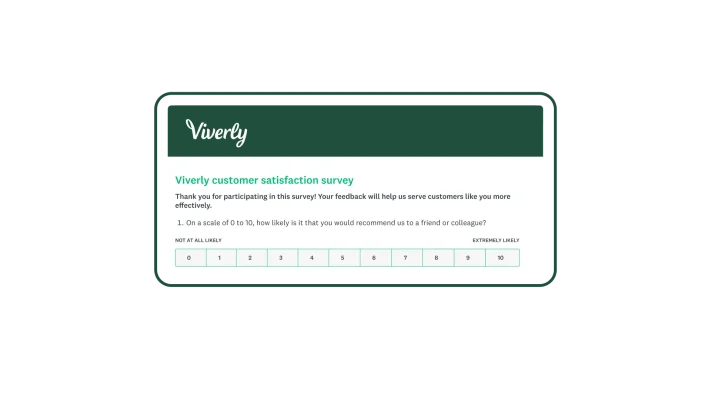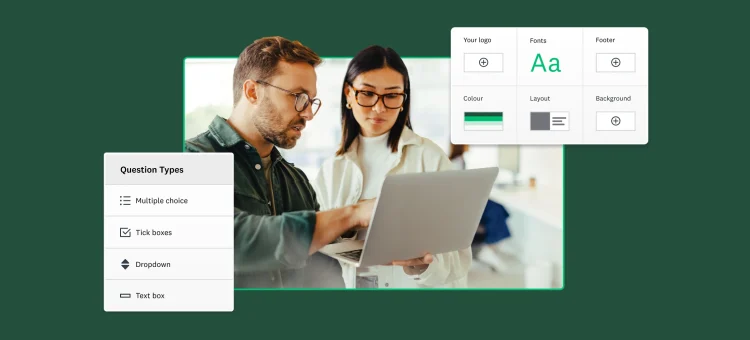Think about the last thing you prepared to eat. Chances are you didn’t choose items from the fridge at random in the hope that they could somehow be combined to make a decent meal. Most people start with an idea of what they want, which limits their ingredients.
It’s not all that much different when it comes to surveys: you wouldn’t create a survey without thinking it through first, primarily because it’s likely that confusing or lengthy surveys will result in bad results.
The great news is that all you need is a survey design plan, which is the foundation of any good survey. A survey design plan keeps you focused, from your overarching goals to the questions that you ask. Here’s how to easily create a survey plan of your own to make sure you get reliable, actionable insights.
Define your survey goals and objectives
A survey goal is a broad statement that is designed to provide a high-level direction or purpose for running your research. Although your survey may indeed have multiple goals, try to limit it to just one or two. Here are a few examples of goals:
- To measure overall satisfaction with our customer support
- To understand customer satisfaction with our product (or service)
- To assess customer loyalty
- To enhance product satisfaction
A survey objective is a specific, measurable and achievable statement that can be validated by conducting your research. One goal can have multiple survey objectives. For example, if your goal is “To measure overall satisfaction with your customer support team”, your objectives could be:
- To measure satisfaction with customer service interaction
- To identify key drivers of satisfaction, such as resolution time satisfaction
- To measure satisfaction with quality of service
In a survey design plan, it’s important to distinguish between goals and objectives. You use your objectives to write good survey questions that are specific and will result in actionable data. Your objectives must align to your goals, which keep you focused. And a focused survey is a shorter survey, which makes it more likely that people will fill it out.
Turn your objectives into survey questions
You now have your objectives. So it’s now time to ask some survey questions that will help you achieve them. Here are some example questions from our ready-to-use customer service survey feedback template:
- Objective: To measure overall satisfaction with customer service interaction
- Question: How satisfied or dissatisfied are you with the service you received?
- Objective: To identify key factors influencing satisfaction, such as resolution time
- Question: How much time did it take us to address your questions and concerns?
- Objective: To measure satisfaction with quality of service
- Question: Overall, how would you rate the quality of your customer service experience?
You’ll need to provide consistent, clear answer choices for each of these questions. That’s because each answer choice corresponds to the survey data that you collect. You’ll probably want to get some written feedback, too. We’ll cover all of that next.

Choose types of questions that give you better data
Once you’ve decided what to ask, you need to decide how to ask. It might be tempting to ask lots of open-ended questions so that you can hear from customers in their own words. However, it’s better to use those questions sparingly and strategically.
Instead, use mostly closed-ended questions. These are survey questions with pre-defined answers that someone chooses from. They are easier for respondents to answer. They also produce data that’s easier to analyse.
There are many different survey question types, each with their specific pros and cons. Here’s an example of a closed-ended multiple choice question:
How much time did it take us to address your questions and concerns?
- Much shorter than expected
- Shorter than expected
- About as long as expected
- Longer than expected
- Much longer than expected
In this example, respondents only choose one answer. Sometimes, you’ll need to use a tick box question, which allows respondents to choose multiple answers. Only use this option when more than one answer could apply.
Take a look at the answer choices above. They range from “much shorter” to “much longer” and are balanced on both sides of the neutral “about what I expected” option. When using scale-based answer options, check to make sure that you have the same number of options in either direction. This helps to prevent bias and gives you more useful data.
Of course, not all rating scales are in the form of words and phrases. One of the most recognisable customer loyalty metrics is the Net Promoter Score® (NPS®). Respondents are asked to rate the likelihood that they would recommend a company on a scale of 0 to 10.

As with any question with a numeric rating scale, you’ll need to make it clear what the numbers actually mean. Here, 0 means “not at all likely” and 10 means “extremely likely”. Without these qualifying words above the numbers, a respondent might feel lost, give an inaccurate answer or simply abandon the survey.
Do you remember those open-ended or text box questions? You can use these to understand why someone rated you the way they did. For example, after someone has rated you from 0 to 10, you can ask them to explain why they gave you the rating they did. It’s a good idea to make this question optional so that people don’t get stuck or become frustrated with your survey.
5 survey design tips to bear in mind
- Ask easier-to-answer questions at the beginning. You can ask harder-to-answer open-ended or sensitive questions towards the end of the survey. This will help to ease your respondent into the survey and reduce their likelihood of dropping out early on. And if your respondent does quit the survey, you’ll still be able to see the answers that they chose before doing so.
- Include demographic survey questions, such as age and location. Use the answers to segment your data, giving you a fuller picture of your target market or audience. If you integrate SurveyMonkey with a platform like Salesforce or Marketo, you can map existing customer information to responses so that you can limit your demographic questions.
- Avoid asking leading and loaded questions. You will receive biased responses when you ask the following question: “Our product has helped many customers like you. How would you rate our product in terms of its helpfulness?” Even using an unbalanced rating scale, with too many options on the “helpful” side, could produce biased answers.
- Focus on one topic per question. Look at this question: “How would you rate the overall quality and timeliness of your customer service interaction?” This is called a double-barrelled question and it’s a common survey mistake. It’s not clear how you would answer this question if you weren’t happy with how long it took but were satisfied overall with the response. Talk about unreliable results.
- Consider offering survey incentives. Whichever industry you’re in, if you’re measuring customer satisfaction, it’s important to keep your survey as short as possible. That said, if you’re conducting research, you might have a much longer survey. To get people to take your survey, you might need to offer an incentive such as a gift card or discount code; otherwise, you run the risk of someone rushing through your survey, thus skewing your results.
How to accelerate your survey design planning
- Do you have an idea for your survey but not much beyond that? We have more than 400 ready-made survey templates for almost any situation. In addition to our templates, we have hundreds of pre-written survey questions in our question bank. Drag and drop questions into your survey design with ease. Our survey templates and questions are written by survey methodologists to reduce bias.
- Rely on our AI-powered survey creation features to improve your survey questions and answers. If you’re writing your own questions, Answer Genius will suggest better phrasing and give you relevant answer choices based on what you’re asking. Alternatively, you can submit a prompt to our Build with AI feature. AI will create a complete survey tailored to your unique needs. You can customise the survey or use it as is.
- Want more help with your survey design plan? Our professional services team is here for you. We offer a range of services from consulting on survey design to results analysis and beyond.
Remember that a solid survey design plan is the foundation of a successful survey. Take the time to define your goals and objectives to capture actionable, reliable data.
How to use a survey design and data analysis plan to drive better insights
Watch this on-demand webinar for more survey design and analysis tips, including how to uncover meaningful results.
NPS®, Net Promoter® and Net Promoter Score® are registered trademarks of Satmetrix Systems, Inc., Bain & Company and Fred Reichheld.



